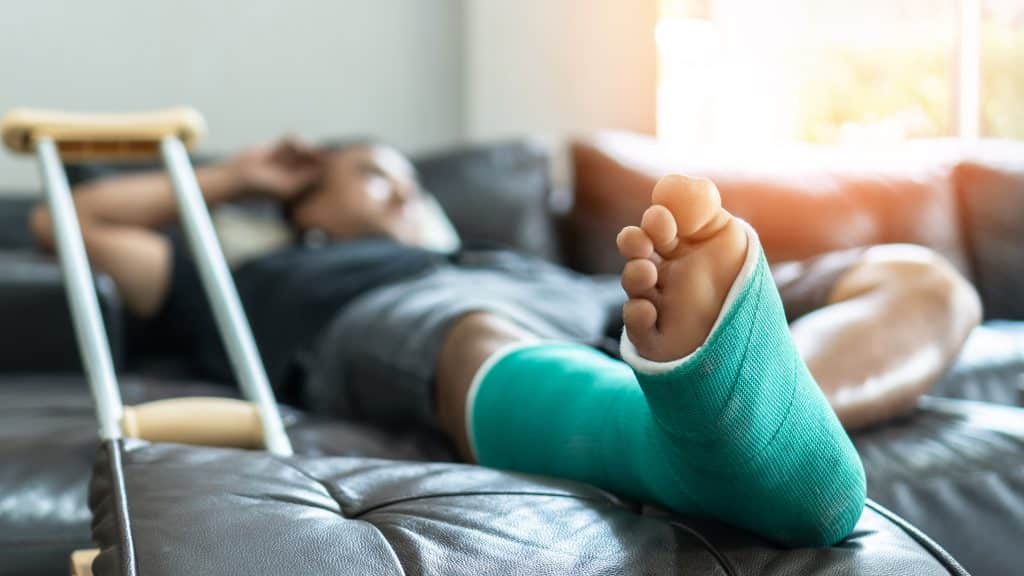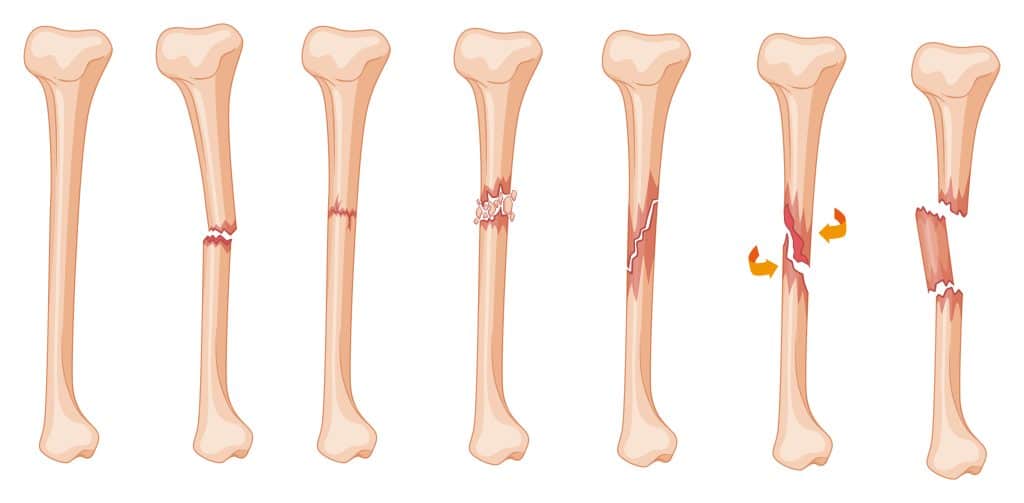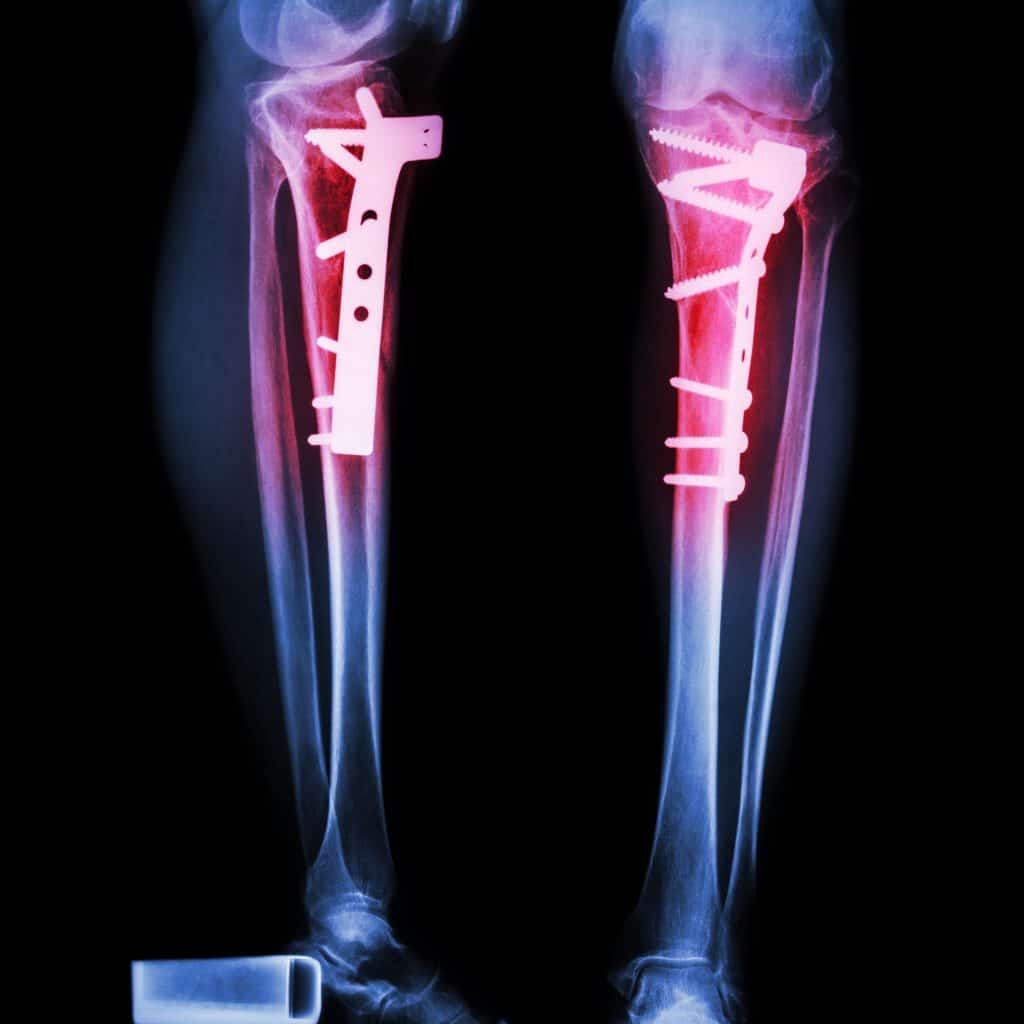Tibia Fractures: Types, Symptoms, & Treatments
The benefits of being active are undeniable: better physical and mental health, improved sleep, and lower disease rates. For those who are regularly active or looking to increase activity levels, a broken leg can be a major setback.
Our legs are made up of three main bones: the tibia, the fibula, and the femur. The femur is the largest bone in the body and is also called the thighbone. The tibia and fibula are the two smaller bones of the lower leg, and the tibia is the larger and thicker of those two. It is located on the inside part of the leg and is commonly called the shinbone.
Tibia Fracture

Although the tibia’s size makes it relatively strong, tibia fractures are common in children and adults. Typical causes include:
- Traumatic events like car accidents, falls, or sports injuries
- Repetitive stress over time, as from activities like running
- Twisting injuries
- Osteoporosis, which is a condition that weakens bones
The tibia supports a significant amount of body weight, so if you suffer a tibia fracture, it will be challenging to do any amount of activity that relies on the lower body. A mild tibial fracture may feel like shin pain, whereas the bone may protrude through the skin in a severely fractured tibia. Common symptoms of a broken tibia include:
- Pain in the shin area
- Bruising and swelling of the lower leg
- Inability to put your weight on that leg, stand normally, or walk
- Obvious deformity or tent-like appearance of the area
- Bone protruding through the skin
- Loss of feeling in your foot
The tibia is integral to the proper functioning of the ankle and knee. Muscles, tendons, and ligaments surround it, so the circumstances that cause a tibial fracture can also damage these surrounding tissues. It is common to also break your fibula when you break your tibia. Always see your sports medicine physician or orthopedic specialist if you think you may have broken your leg.
Types of Tibia Fractures
Your orthopedic specialist will use various terms to describe the type of fracture you have. These include:

- Transverse, oblique, or spiral: Respectively, these terms mean the break is horizontal, at an angle, or twists around the bone.
- Displaced or nondisplaced: Displaced fractures are those where the bone pieces move out of their normal position. In non-displaced (or stable) fractures, the broken parts of the tibia stay in the correct alignment. Displaced fractures must be reduced (set) to heal properly.
- Open or closed: In an open fracture, the bone breaks through the skin. These fractures are more prone to infection and usually require antibiotics during their initial healing. In closed fractures, all sections of the broken bone remain inside the body.
- Comminuted: Comminuted fractures are those where the bone breaks into three or more pieces. These fractures typically require surgery.
- Stress or hairline: Stress fractures often result from repetitive stress and overuse. They’re generally small and thin but still require treatment and healing time.
- Partial or complete: Complete breaks cross the entire bone, whereas partial breaks do not.
- Proximal or distal: Proximal tibial fractures (also called tibial plateau fractures) happen closer to the knee. A distal tibia fracture is closer to the ankle. A shaft or middle fracture occurs along the length of the bone.
Diagnosis of a Tibia Fracture
Your orthopedic specialist will determine the extent of the injury and proper treatment by using a physical exam and X-ray. They may also use a CT scan or MRI to get additional details and check for damage to surrounding tissues. Because tibial fractures can affect growth plates, proper diagnosis and treatment are integral for growing children.

Treatment and recovery from a tibia fracture depend on the cause and severity of the injury as well as your overall health, activity level, and treatment goals. Severe breaks that are displaced, open, or comminuted likely require surgery. Your orthopedic surgeon might use intramedullary nailing or internal fixation (plates, screws, or other hardware inserted under the skin), external fixation (metal frame or other hardware screwed through the skin), or percutaneous pinning (inserting pins or wires through the skin and across the bone) to hold the bone in place while it heals.
Non-surgical treatments include using a splint, brace, or cast to support the bone and prevent it from moving.
Most treatment plans also include physical therapy as essential to regaining your strength and range of motion. You may also do exercises to strengthen the hips, calves, and thighs to take some weight off the tibia (and help prevent future injuries). Crutches or a walker will also be necessary for most patients as they work toward putting their full weight back on that leg.
How long does a fractured tibia take to heal?
A fractured tibia generally heals in 4 to 6 months but may take longer if the break is complicated or requires surgery. Additional time is typically necessary before fully returning to normal activities and exercises. Using nonsteroidal anti-inflammatory drugs as directed, icing the area, and elevating your leg can help with any pain.
Always work closely with your orthopedic specialist to monitor your tibia for proper healing. Complications from tibial fractures or surgery are not common, but they are possible.
If you’d like to talk to an orthopedic specialist about a leg injury or practices that keep your bones healthy, please contact us or comment below.
4 Comments
Permalink
I went the ER and was diagnosed with a comminuted tibial plateau fracture. The radiologist did not show me the mri or ct scans. When it happened I was able to walk & drove myself to the hospital. I also feel no pain, no loss of feeling in my foot, the area has a minimal amount of swelling, and I actually have walked in the knee brace a couple times without assistance of crutches. I was told I need to follow up with an orthopedic surgeon immediately and was referred to an affiliate company. I’ve called the company everyday, who has said several times a provider will follow up with me the same day, but I have not received a call. questioning the diagnosis?
Permalink
Hi Preston,
A comminuted tibial plateau fracture, diagnosed despite minimal pain and swelling and the ability to walk, requires immediate orthopedic evaluation due to its potential complications. Despite multiple attempts to follow up with the referred orthopedic provider without success, it is crucial to continue seeking an appointment due to the serious nature of the injury. If the current referral remains unresponsive, consider contacting other orthopedic specialists directly, seeking help from your primary care physician, or returning to the ER for assistance. Prompt and appropriate management is essential for proper healing and to prevent long-term issues.
Permalink
I do competitive cheerleading and when I was tumbling I landed and heard something from my leg and had trouble walking after that and i still have trouble. i don’t know what it is bc it is in between my knee and ankle. i think it is my calf. how do i know if it is broken,fractured,sprained,etc… should I go to the doctor or get an x ray?
Permalink
Hi London, It sounds like you may have experienced a significant injury during your tumbling. Given the location and symptoms you’ve described, I would suggest that you consider consulting with an orthopedic specialist or sports medicine doctor. They can evaluate your injury, possibly order an X-ray or other imaging tests, and recommend the best course of action for your recovery. It’s always better to err on the side of caution when it comes to your health and well being.